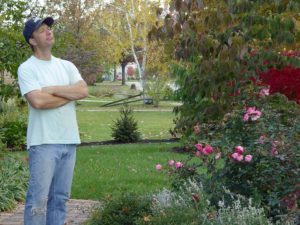Editing the Landscape
September 20th, 2022
One of the best ways to continually improve a landscape is to take stock of how things are going each year and then make changes and additions based on what you like – and don’t like.

I’m constantly on the lookout for ways to “edit” the landscape.
September is an excellent time to do this “inspecting of the troops.”
It’s good timing because we’ve had most of another whole season to see how things are going, plus it’s a good window for both planting and transplanting most plants.
In central Pennsylvania, early fall is a time when temperatures cool, rain usually becomes more plentiful, and the soil stays warm enough long enough for good root establishment.
I’ve long used this time to walk around the landscape with a critical eye and a clipboard to make notes on what changes I’d like to make.
Even if I don’t do the deed this fall, I have notes ready to go for next season’s plantings and transplantings.
Some things to look for while on inspection:
1.) Plants that are struggling or dead. I’ve saved many a plant by recognizing early on that it’s in a bad spot or otherwise failing to thrive. Digging, improving the soil, and/or moving a struggler altogether is better than just letting a doomed plant slide downhill until death.
Read more about this in my post on “Failure to Thrive.”
2.) Plants that are spreading too far or getting overgrown. This is a good time of year to assess this.
One of the ways I’ve expanded my flock at no cost over the years is dividing and moving perennials. I’ve also filled many a new bed by transplanting young shrubs and evergreens that I otherwise would have had to start pruning to maintain size in their tighter original locations.
I should mention here that most plants (especially young ones) transplant better than most gardeners think. Read my post on “Transplantaphobia” for more on how to maximize your success when moving plants.
3.) Plants that would just look better in another location in the landscape. I’m constantly on the lookout for better combinations. Often a move is in order because I got a new trial plant or bought some new plants that go really well with an existing plant I have in another location.

I like this part of my driveway terrace where the rosy-pink flowers of Summer Crush hydrangea pair well with the silvery variegated foliage of Silver Heart brunnera.
What I do is make notes and think about the best location where I can “marry” good neighbors that are in two different spots.
4.) Bare spots or gardens that just aren’t working. Sometimes things die and create openings that have to be filled.
Other times I just don’t like where I’ve placed a plant. Or I’ll find that a plant is running into way too many bug or disease issues to justify keeping. Or occasionally I’ll run into something that I just don’t like at all.
These become candidates for the compost pile – and create wish-list openings on the clipboard.
When I add it all up, I end up with an “action list.” I then think about when I should do what, leading to a numbered game of “musical plants” that’s actually one of the most fun times I have in the garden.
This year, for example, I’m moving a thriving fothergilla ‘Mt. Airy’ from my back-yard cottage garden out to the driveway bed where a grouping of five ‘Mt. Airy’ plants aren’t doing so well. (I plan to group two strugglers together and give them a boost with a five-gallon bucket of compost.)
In the opening created by the moved ‘Mt. Airy,’ I’ll move a sweetbox that’s in too much sun along with a ‘Hot Lips’ turtlehead and a pink Japanese anemone that have been browsed by deer in an unprotected driveway terrace.
In the spot vacated by the sweetbox, I’ll move one of four dwarf variegated weigelas that also got browsed by deer in another part of the driveway beds.
And where the turtlehead and anemone are leaving, I’ll fill in with divisions from an existing patch of sweet woodruff and an existing patch of Chinese astilbe.
One move usually leads to another. In this case, I’ll be making improvements to four different garden areas without buying a single new plant.
By doing this once or even twice every year (spring and fall), the landscape will get better and better every year.
I don’t look at it as wasted work or feel bad because I wasn’t smart enough to get everything right on the first try.
I look at it as “editing.”
And if editing makes writing better, musical plants should make the landscape better.







